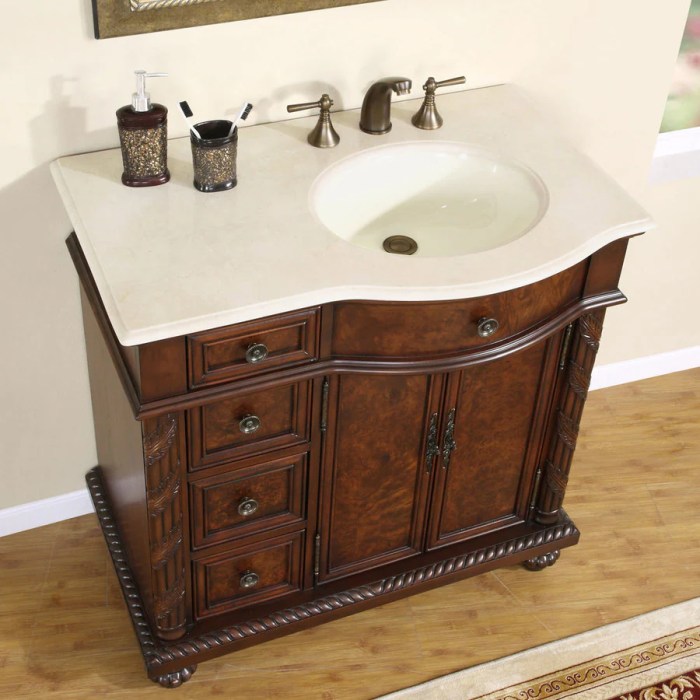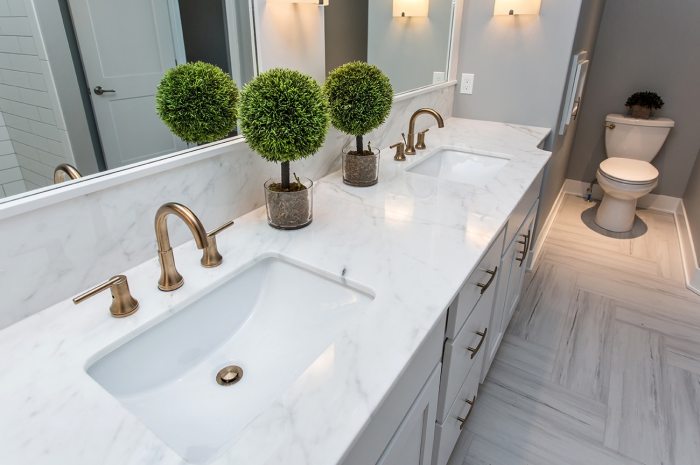Transform your bathroom into an oasis of effortless style with low-maintenance vanity surfaces. From the chic sophistication of granite to the timeless appeal of marble, these materials offer a perfect blend of durability and aesthetic charm. Dive into our comprehensive guide to explore the world of low-maintenance bathroom vanity surfaces, empowering you to create a space that radiates beauty and ease.
With a focus on materials, design considerations, installation techniques, and cost implications, this guide provides an in-depth understanding of everything you need to know about low-maintenance bathroom vanity surfaces. Whether you’re embarking on a bathroom renovation or simply seeking inspiration, this guide will equip you with the knowledge to make informed decisions and create a bathroom that meets your needs and exceeds your expectations.
Materials for Low-Maintenance Bathroom Vanity Surfaces
Choosing the right material for your bathroom vanity surface is essential for creating a durable and easy-to-clean space. Here are some of the most popular options and their pros and cons:
Granite
- Pros: Granite is a natural stone that is extremely durable and resistant to scratches and stains. It is also relatively easy to clean and maintain.
- Cons: Granite can be expensive, and it is important to seal it regularly to prevent staining.
Quartz
- Pros: Quartz is a man-made material that is even more durable than granite. It is also non-porous, which makes it resistant to stains and bacteria.
- Cons: Quartz can be more expensive than granite, and it can be difficult to find a perfect match for your existing décor.
Marble
- Pros: Marble is a beautiful natural stone that adds a touch of luxury to any bathroom. It is also relatively easy to clean and maintain.
- Cons: Marble is not as durable as granite or quartz, and it is more susceptible to staining and scratching.
Laminate
- Pros: Laminate is a budget-friendly option that is available in a wide variety of colors and styles. It is also easy to clean and maintain.
- Cons: Laminate is not as durable as granite, quartz, or marble, and it can be damaged by heat or moisture.
Design Considerations for Low-Maintenance Vanity Surfaces
When designing a bathroom with low-maintenance vanity surfaces, it’s essential to consider the size, shape, and style that best suits your space and needs. The size should be proportionate to the bathroom, with enough space for toiletries and other essentials without overwhelming the room.
The shape can influence the overall aesthetic, with rectangular vanities providing a classic look and oval or round vanities adding a touch of softness. The style should complement the bathroom’s decor, whether it’s traditional, modern, or contemporary.Incorporating low-maintenance materials into different bathroom designs requires careful planning.
For a modern bathroom, sleek and durable materials like quartz or porcelain tiles can create a sophisticated and easy-to-clean surface. In a traditional bathroom, natural stone or marble can add a touch of elegance and warmth while still being relatively low-maintenance.
For a contemporary bathroom, solid surface materials like Corian or acrylic can provide a seamless and hygienic surface.When selecting complementary fixtures and accessories, opt for pieces that enhance the functionality and style of your vanity surface. Wall-mounted faucets can free up counter space, while under-mount sinks create a sleek and modern look.
Accessories like soap dispensers and toothbrush holders should match the finish of your vanity surface and add a touch of personal style.
Installation and Maintenance of Low-Maintenance Vanity Surfaces
Installing low-maintenance vanity surfaces is a relatively straightforward process, but there are a few special considerations to keep in mind. First, it is important to choose a surface that is compatible with the type of vanity you have. Some surfaces, such as quartz, are more durable and can be used on both traditional and floating vanities.
Others, such as laminate, are less durable and are best suited for floating vanities.Once you have chosen a surface, you will need to prepare the vanity for installation. This may involve removing the old surface, cleaning the vanity, and leveling the surface.
Once the vanity is prepared, you can begin installing the new surface.The installation process will vary depending on the type of surface you have chosen. However, there are some general steps that apply to all surfaces. First, you will need to apply a thin layer of adhesive to the back of the surface.
Then, you will need to carefully place the surface on the vanity and press it into place. Once the surface is in place, you will need to weight it down with something heavy, such as a stack of books. This will help to keep the surface in place while the adhesive dries.Once
the adhesive has dried, you will need to seal the surface. This will help to protect the surface from water and stains. The type of sealer you use will depend on the type of surface you have chosen.
Cleaning and Maintaining Low-Maintenance Vanity Surfaces
Low-maintenance vanity surfaces are relatively easy to clean and maintain. However, there are a few things you should keep in mind to ensure that your surface stays looking its best.First, it is important to clean the surface regularly. This will help to remove dirt and grime and prevent stains from setting in.
You can clean the surface with a mild detergent and water. Be sure to rinse the surface thoroughly after cleaning.In addition to regular cleaning, you should also deep clean the surface periodically. This will help to remove any built-up dirt or grime.
To deep clean the surface, you can use a stronger cleaning solution, such as a vinegar and water mixture. Be sure to rinse the surface thoroughly after deep cleaning.
Frequency of Maintenance
The frequency of maintenance required for low-maintenance vanity surfaces will vary depending on the type of surface you have chosen. However, most surfaces will need to be cleaned regularly and deep cleaned periodically.
Specific Products or Techniques
There are a few specific products or techniques that you can use to clean and maintain low-maintenance vanity surfaces.*
- *Use a mild detergent and water to clean the surface. Be sure to rinse the surface thoroughly after cleaning.
- *Use a vinegar and water mixture to deep clean the surface. Be sure to rinse the surface thoroughly after deep cleaning.
- *Use a soft cloth to wipe down the surface. Avoid using abrasive cloths or sponges, as these can damage the surface.
- *Use a sealant to protect the surface from water and stains. The type of sealer you use will depend on the type of surface you have chosen.
Cost and Value of Low-Maintenance Vanity Surfaces
Low-maintenance vanity surfaces offer a balance of cost and durability. The initial investment may be higher than traditional materials, but the long-term savings on repairs and replacements can make them a worthwhile choice.
Cost Comparison
The cost of low-maintenance vanity surfaces varies depending on the material, size, and design. Quartz and solid surface materials are typically more expensive than laminate or cultured marble. However, they are also more durable and require less maintenance.
Return on Investment
The return on investment for low-maintenance vanity surfaces can be significant. By reducing the need for repairs and replacements, these surfaces can save you money over time. Additionally, they can increase the value of your home, as potential buyers appreciate the convenience and durability of these materials.
Budgeting Considerations
When budgeting for a low-maintenance bathroom vanity surface, consider the following factors:*
-*Size of the vanity
Larger vanities will require more material, which can increase the cost.
-
-*Material choice
Quartz and solid surface materials are more expensive than laminate or cultured marble.
-*Design complexity
Custom designs or unusual shapes can also add to the cost.
-*Installation
Professional installation is recommended for all vanity surfaces, and the cost of installation will vary depending on the complexity of the job.
Last Point
Embrace the beauty of low-maintenance bathroom vanity surfaces and elevate your bathroom to new heights of style and functionality. By choosing the right materials, incorporating thoughtful design elements, and following proper installation and maintenance practices, you can create a bathroom that stands the test of time while effortlessly maintaining its pristine appearance.
Remember, a low-maintenance bathroom vanity surface is not just a practical choice; it’s an investment in the beauty and tranquility of your personal sanctuary.



